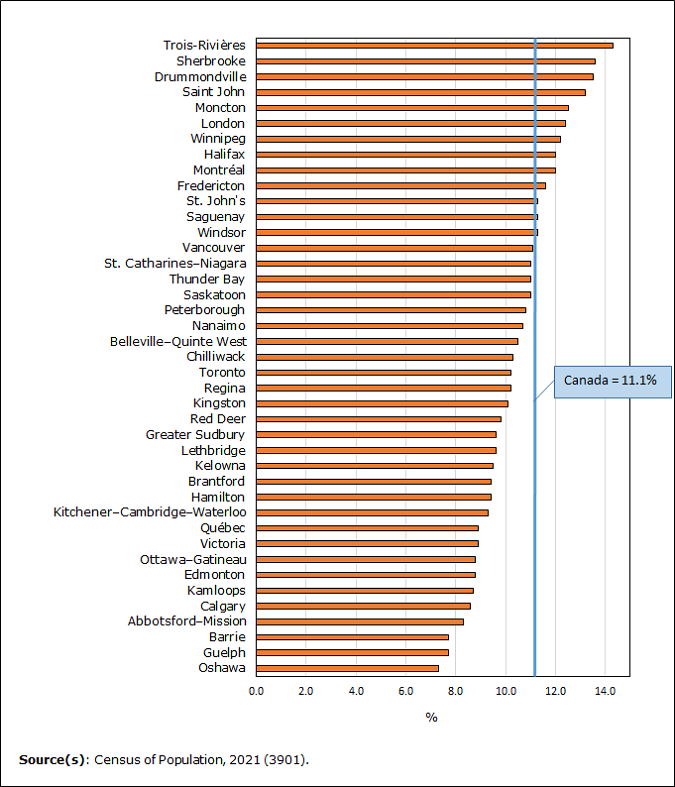Infographic 10
The low-income rate was highest in Trois-Rivières, Sherbrooke and Drummondville in 2020

Infographic description
The title of the infographic is "The low-income rate was highest in Trois-Rivières, Sherbrooke and Drummondville in 2020"
The vertical axis shows census metropolitan areas: Trois-Rivières, Sherbrooke, Drummondville, Saint John, Moncton, London, Winnipeg, Halifax, Montréal, Fredericton, St. John's, Saguenay, Windsor, Vancouver, St. Catharines–Niagara, Thunder Bay, Saskatoon, Peterborough, Nanaimo, Belleville–Quinte West, Chilliwack, Toronto, Regina, Kingston, Red Deer, Greater Sudbury, Lethbridge, Kelowna, Brantford, Hamilton, Kitchener–Cambridge–Waterloo, Québec, Victoria, Ottawa–Gatineau, Edmonton, Kamloops, Calgary, Abbotsford–Mission, Barrie, Guelph, and Oshawa.
The horizontal axis shows the low income rate (%) from -1.0% to 15.0%, by increments of 2.0%.
There is a vertical line at 11.1 shows the national average of low income rate.
The bars descend, with Trois-Rivières at 14.3%, Sherbrooke at 13.6%, Drummondville at 13.5%, Saint John at 13.2%, Moncton at 12.5%, London at 12.4%, Winnipeg at 12.2%, Halifax at 12.0%, Montréal at 12.0%, Fredericton at 11.6%, St. John's at 11.3%, Saguenay at 11.3%, Windsor at 11.3%, Vancouver at 11.1%, St. Catherines–Niagara at 11.0%, Thunder Bay at 11.0%, Saskatoon at 11.0%, Peterborough at 10.8%, Nanaimo at 10.7%, Belleville–Quinte West at 10.5%, Chilliwack at 10.3%, Toronto at 10.2%, Regina at 10.2%, Kingston at 10.1%, Red Deer at 9.8%, Greater Sudbury at 9.6%, Lethbridge at 9.6%, Kelowna at 9.5%, Brantford at 9.4%, Hamilton at 9.4%, Kitchener–Cambridge–Waterloo at 9.3%, Québec at 8.9%, Victoria at 8.9%, Ottawa–Gatineau at 8.8%, Edmonton at 8.8%, Kamloops at 8.7%, Calgary at 8.6%, Abbotsford–Mission at 8.3%, Barrie at 7.7%, Guelph at 7.7%, and Oshawa at 7.3%.
Source(s): Census of Population, 2021 (3901).
- Date modified: